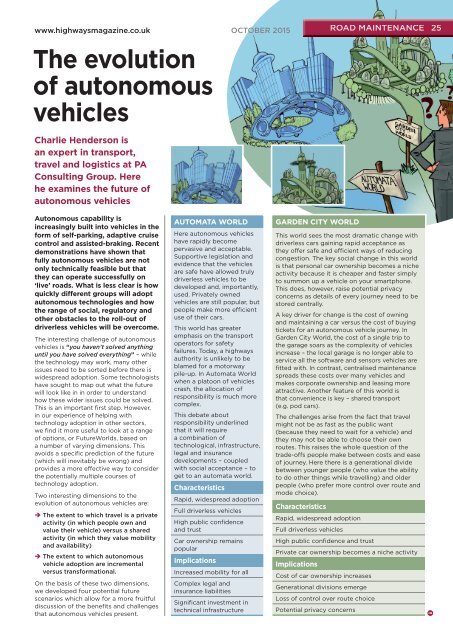Andrew Jones
Highways_October_2015
Highways_October_2015
Create successful ePaper yourself
Turn your PDF publications into a flip-book with our unique Google optimized e-Paper software.
www.highwaysmagazine.co.uk OCTOBER 2015<br />
The evolution<br />
of autonomous<br />
vehicles<br />
ROAD MAINTENANCE 25<br />
Charlie Henderson is<br />
an expert in transport,<br />
travel and logistics at PA<br />
Consulting Group. Here<br />
he examines the future of<br />
autonomous vehicles<br />
Autonomous capability is<br />
increasingly built into vehicles in the<br />
form of self-parking, adaptive cruise<br />
control and assisted-braking. Recent<br />
demonstrations have shown that<br />
fully autonomous vehicles are not<br />
only technically feasible but that<br />
they can operate successfully on<br />
‘live’ roads. What is less clear is how<br />
quickly different groups will adopt<br />
autonomous technologies and how<br />
the range of social, regulatory and<br />
other obstacles to the roll-out of<br />
driverless vehicles will be overcome.<br />
The interesting challenge of autonomous<br />
vehicles is “you haven’t solved anything<br />
until you have solved everything” – while<br />
the technology may work, many other<br />
issues need to be sorted before there is<br />
widespread adoption. Some technologists<br />
have sought to map out what the future<br />
will look like in in order to understand<br />
how these wider issues could be solved.<br />
This is an important first step. However,<br />
in our experience of helping with<br />
technology adoption in other sectors,<br />
we find it more useful to look at a range<br />
of options, or FutureWorlds, based on<br />
a number of varying dimensions. This<br />
avoids a specific prediction of the future<br />
(which will inevitably be wrong) and<br />
provides a more effective way to consider<br />
the potentially multiple courses of<br />
technology adoption.<br />
Two interesting dimensions to the<br />
evolution of autonomous vehicles are:<br />
è The extent to which travel is a private<br />
activity (in which people own and<br />
value their vehicle) versus a shared<br />
activity (in which they value mobility<br />
and availability)<br />
è The extent to which autonomous<br />
vehicle adoption are incremental<br />
versus transformational.<br />
On the basis of these two dimensions,<br />
we developed four potential future<br />
scenarios which allow for a more fruitful<br />
discussion of the benefits and challenges<br />
that autonomous vehicles present.<br />
AUTOMATA WORLD<br />
Here autonomous vehicles<br />
have rapidly become<br />
pervasive and acceptable.<br />
Supportive legislation and<br />
evidence that the vehicles<br />
are safe have allowed truly<br />
driverless vehicles to be<br />
developed and, importantly,<br />
used. Privately owned<br />
vehicles are still popular, but<br />
people make more efficient<br />
use of their cars.<br />
This world has greater<br />
emphasis on the transport<br />
operators for safety<br />
failures. Today, a highways<br />
authority is unlikely to be<br />
blamed for a motorway<br />
pile-up. In Automata World<br />
when a platoon of vehicles<br />
crash, the allocation of<br />
responsibility is much more<br />
complex.<br />
This debate about<br />
responsibility underlined<br />
that it will require<br />
a combination of<br />
technological, infrastructure,<br />
legal and insurance<br />
developments – coupled<br />
with social acceptance – to<br />
get to an automata world.<br />
Characteristics<br />
Rapid, widespread adoption<br />
Full driverless vehicles<br />
High public confidence<br />
and trust<br />
Car ownership remains<br />
popular<br />
Implications<br />
Increased mobility for all<br />
Complex legal and<br />
insurance liabilities<br />
Significant investment in<br />
technical infrastructure<br />
GARDEN CITY WORLD<br />
This world sees the most dramatic change with<br />
driverless cars gaining rapid acceptance as<br />
they offer safe and efficient ways of reducing<br />
congestion. The key social change in this world<br />
is that personal car ownership becomes a niche<br />
activity because it is cheaper and faster simply<br />
to summon up a vehicle on your smartphone.<br />
This does, however, raise potential privacy<br />
concerns as details of every journey need to be<br />
stored centrally.<br />
A key driver for change is the cost of owning<br />
and maintaining a car versus the cost of buying<br />
tickets for an autonomous vehicle journey. In<br />
Garden City World, the cost of a single trip to<br />
the garage soars as the complexity of vehicles<br />
increase – the local garage is no longer able to<br />
service all the software and sensors vehicles are<br />
fitted with. In contrast, centralised maintenance<br />
spreads these costs over many vehicles and<br />
makes corporate ownership and leasing more<br />
attractive. Another feature of this world is<br />
that convenience is key – shared transport<br />
(e.g. pod cars).<br />
The challenges arise from the fact that travel<br />
might not be as fast as the public want<br />
(because they need to wait for a vehicle) and<br />
they may not be able to choose their own<br />
routes. This raises the whole question of the<br />
trade-offs people make between costs and ease<br />
of journey. Here there is a generational divide<br />
between younger people (who value the ability<br />
to do other things while travelling) and older<br />
people (who prefer more control over route and<br />
mode choice).<br />
Characteristics<br />
Rapid, widespread adoption<br />
Full driverless vehicles<br />
High public confidence and trust<br />
Private car ownership becomes a niche activity<br />
Implications<br />
Cost of car ownership increases<br />
Generational divisions emerge<br />
Loss of control over route choice<br />
Potential privacy concerns



